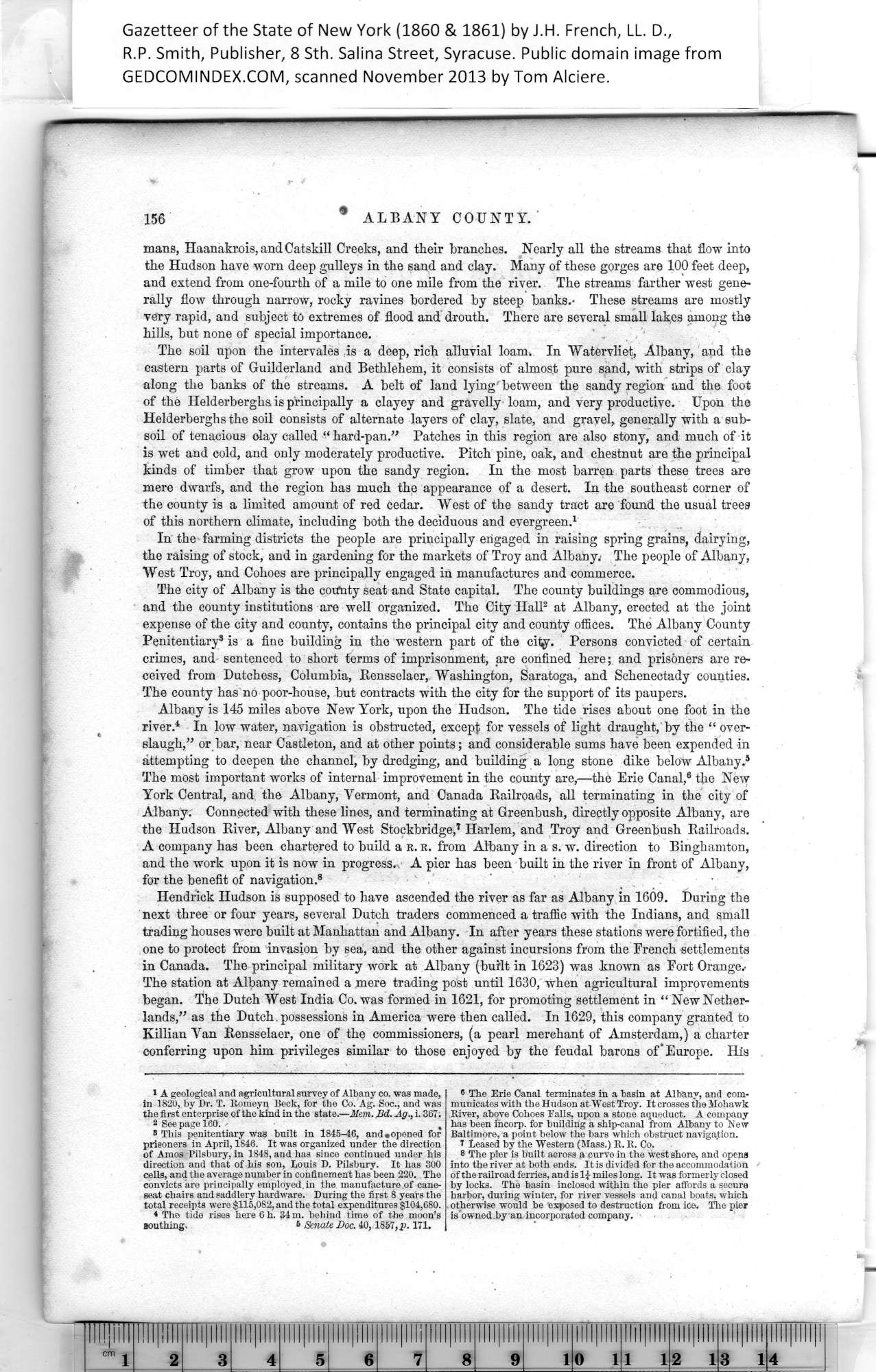|
156 * ALBANY COUNTY.
mans, Haanakrois, and Catskiil Creeks, and their branches. Nearly all the streams that flow into
the Hudson have worn deep gulleys in the sand and clay. Many of these gorges are 100 feet deep,
and extend from one-fourth of a mile to one mile from the river. The streams farther west gene¬
rally flow through narrow, rocky ravines bordered by steep banks.- These streams are mostly
very rapid, and subject to extremes of flood and drouth. There are several small lakes among the
hills, but none of special importance.
The soil upon the intervales is a deep, rich alluvial loam. In Watervliet, Albany, and the
eastern parts of Guilderland and Bethlehem, it consists of almost pure sand, with strips of clay
along the banks of the streams. A belt of land lying between the sandy region and the foot
of the Helderberghs is principally a clayey and gravelly loam, and very productive. Upon the
Helderberghs the soil consists of alternate layers of clay, slate, and gravel, generally with a sub¬
soil of tenacious olay called “hard-pan.” Patches in this region are also stony, and much of it
is wet and cold, and only moderately productive. Pitch pine, oak, and chestnut are the principal
kinds of timber that grow upon the sandy region. In the most barren parts these trees are
mere dwarfs, and the region has much the appearance of a desert. In the southeast corner of
the county is a limited amount of red cedar. West of the sandy tract are found the usual trees
of this northern climate, including both the deciduous and evergreen.1
In the farming districts the people are principally engaged in raising spring grains, dairying,
the raising of stock, and in gardening for the markets of Troy and Albany. The people of Albany,
West Troy, and Cohoes are principally engaged in manufactures and commerce.
The city of Albany is the county seat and State capital. The county buildings are commodious,
and the county institutions are well organized. The City Hall2 at Albany, erected at the joint
expense of the city and county, contains the principal city and county offices. The Albany County
Penitentiary3 is a fine building in the western part of the city. Persons convicted of certain
crimes, and sentenced to short terms of imprisonment, are confined here; and prisoners are re¬
ceived from Dutchess, Columbia, Rensselaer, Washington, Saratoga, and Schenectady counties.
The county has no poor-house, but contracts with the city for the support of its paupers.
Albany is 145 miles above New York, upon the Hudson. The tide rises about one foot in the
river.1 In low water, navigation is obstructed, except for vessels of light draught, by the “ over¬
slaugh,” or bar, near Castleton, and at other points; and considerable sums have been expended in
attempting to deepen the channel, by dredging, and building a long stone dike below Albany.2
The most important works of internal improvement in the county are,—the Erie Canal,6 the New
York Central, and the Albany, Vermont, and Canada Railroads, all terminating in the city of
Albany. Connected with these lines, and terminating at Greenbush, directly opposite Albany, are
the Hudson River, Albany and West Stockbridge,3 Harlem, and Troy and Greenbush Railroads.
A company has been chartered to build a k. e. from Albany in a s. w. direction to Binghamton,
and the work upon it is now in progress. A pier has been built in the river in front of Albany,
for the benefit of navigation.4
Hendrick Hudson is supposed to have ascended the river as far as Albany in 1609. During the
next three or four years, several Dutch traders commenced a traffic with the Indians, and small
trading houses were built at Manhattan and Albany. In after years these stations were fortified, the
one to protect from invasion by sea, and the other against incursions from the French settlements
in Canada. The principal military work at Albany (built in 1623) was known as Fort Orange.-
The station at Albany remained a mere trading post until 1630, when agricultural improvements
began. The Dutch West India Co. was formed in 1621, for promoting settlement in “ New Nether¬
lands,” as the Dutch. possessions in America were then called. In 1629, this company granted to
Killian Van Rensselaer, one of the commissioners, (a pearl merchant of Amsterdam,) a charter
conferring upon him privileges similar to those enjoyed by the feudal barons of’Europe. His
|
® The Erie Canal terminates in a basin at Albany, and com¬
municates with the Hudson at West Troy. It crosses the Mohawk
River, above Cohoes Palls, upon a stone aqueduct. A company
has been incorp. for building a ship-canal from Albany to New
Baltimore, a point below the bars which obstruct navigation.
I Leased by the Western (Mass.) R. B. Co.
8 The pier is built across a curve in the west shore, and opens
into the river at both ends. It is divided for the accommodation
of the railroad ferries, and is 1£ miles long. It was formerly closed
by locks. The basin inclosed within the pier affords a secure
harbor, during winter, for river vessels and canal boats, which
otherwise would be exposed to destruction from ice. The pier
is owned by an incorporated company. |
1
A geological and agricultural survey of Albany co. was made,
in 1820, by Dr. T. Romeyn Beck, for the Co. Ag. Soc., and was
the first enterprise of the kind in the state.—Mem. Bd. Ag., i. 367;
2
convicts are principally employed in the manufacture of cane-
3
total receipts were $115,082, and the total expenditures $104,680.
4
* The tide rises here 6h. 34: m. behind time of the moon’s
southing. 6 Senate Doc. 40,1857, p. 171.
|
